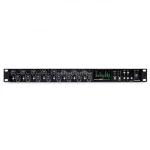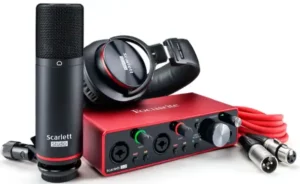
Focusrite Scarlett 2i2 Studio

Introduction
Thank you for purchasing the Second Generation Scarlett 2i2 Studio, part of the range of Focusrite professional audio interfaces incorporating high quality, Focusrite analogue pre-amplifiers. You now have a simple, compact and complete solution for recording with a microphone or directly from instruments, by routing high quality audio to and from your computer.
In developing the Second Generation series of Scarlett interfaces, we have enhanced both the performance and feature set including support for sample rates up to 192 kHz, improved mic preamp performance with low noise and plenty of gain, and upgraded instrument inputs with additional headroom for recording the loudest guitar parts without clipping. They are class compliant on Mac, which means they are plug-and-play, so no need to install a driver if you are a Mac user. You will also be able to download some exciting new software plug-ins once you’ve registered the product.
This User Guide provides a detailed explanation of the components to help you achieve a thorough understanding of the Scarlett 2i2’s operational features. We recommend that whether you are new to recording or a more experienced user, you should take the time to read through the User Guide so that you are fully aware of all the possibilities that the Scarlett Studio components and accompanying software has to offer. If the main User Guide sections do not provide the information you need, be sure to consult support.focusrite.com, which contains a comprehensive collection of answers to common technical support queries.
Features
The Scarlett Studio package comprises a Scarlett 2i2 audio interface, a Scarlett Studio CM25 MkII studio quality condenser microphone, a pair of Scarlett Studio HP60 MkII reference quality headphones and all the necessary software to get you started with recording great audio on your computer as quickly as possible.
The Scarlett 2i2 hardware interface is the key component in the Scarlett 2i2 Studio system; this provides the means of connecting the CM25 MkII (or other) microphone, musical instruments or line level audio signals to a computer running Mac OS or Windows. The signals applied at the 2i2’s physical inputs can be routed to your recording software via a USB connection. Similarly, the recording software’s monitor or recorded output will appear at the 2i2’s physical outputs. (Note – audio recording software is frequently referred to as a “Digital Audio Workstation”, or “DAW”, and the term “DAW” is used throughout this user guide.)
Audio sources – mics, instruments, etc. – connected to the 2i2’s physical inputs can be recorded in the DAW and then routed from your DAW to the physical outputs. The 2i2’s various physical outputs can be connected to the HP60 MkII headphones, or if you wish, to an amplifier and speakers, powered monitors, analogue mixer or any other analogue audio equipment that you wish to use. Although all inputs and outputs on the Scarlett 2i2 are routed directly to and from your DAW for recording and playback, you can configure the routing within your DAW in order to meet your needs.
Box Contents
You should find that your Scarlett 2i2 Studio package comprises:
- Scarlett 2i2 (2nd Gen.) audio interface
- Scarlett Studio CM25 MkII condenser microphone and microphone clip
- Scarlett Studio HP60 MkII headphones
- Bundle code* for accessing the following on-line resources:
- Focusrite Red 2 & 3 Plug-in Suite
- Pro Tools | First
- Ableton Live Lite
- LoopMasters sample library
- Red XLR microphone cable (3 m)
- USB cable
- Getting Started Guide and Important Safety Information*
information printed on the inside of the gift box
System requirements
Mac OS & Windows
For information on System Requirements for the Scarlett and the optional bundled software, please visit:
GETTING STARTED
IMPORTANT: WINDOWS USERS – PLEASE ENSURE THAT YOU RUN THE INSTALLER BEFORE CONNECTING THE SCARLETT 2i2 TO YOUR COMPUTER.
THE SECOND GENERATION SCARLETT 2i2 IS CLASS COMPLIANT FOR MACS, THEREFORE DRIVER INSTALLATION IS NOT NECESSARY.
Software Installation
All software required by the Scarlett 2i2 – and several powerful and useful extras – is available for download from the Focusrite website www.focusrite.com/register. You will find a “Bundle Code” printed on the inside of the gift box your Scarlett 2i2 comes in, and the Serial number can be found on the underside of the unit. You will need to enter these when you access the downloads area of the website; this procedure ensures that you will have the most up-to-date software versions.
DOWNLOADING THE INCLUDED SOFTWARE
To download the included software, you will need to register your Scarlett 2i2 at focusrite.com/register and enter BUNDLE CODE below when prompted.
For an in depth video tutorial, please go to focusrite.com/get-started
- Using your usual browser, go to www.focusrite.com/register/.
- Follow the on-screen instructions, entering the Serial number and then the Bundle Code (XXXXXX-XXXXXX-XXXXXX) into the form where prompted. Your Bundle Code is printed on the inside of the gift box.
- You will then be able to access the “My Products” page, where the software products to which your registration entitles you are available for download, complete with activation codes where applicable.
- Download and install the Scarlett 2i2 drivers (Windows only). Follow all on-screen instructions.
- When the installation is complete, restart your computer.
- After restart, connect the Scarlett 2i2 to your computer with the USB cable supplied.
This information is accurate as of May 2016, however we are constantly striving to improve the customer experience and as a result this process is subject to change. If anything appears to have changed please refer to www.focusrite.com/get-started for the latest info.
Mac OS only:
Your OS should automatically switch the computer’s default audio inputs & outputs to the Scarlett 2i2. To verify this, go to System Preferences > Sound, and ensure that the input and output are set to Scarlett 2i2. For more detailed setup options on a Mac, open Applications > Utilities > Audio MIDI Setup.
Windows only:
Your OS should automatically switch the computer’s default audio inputs & outputs to the Scarlett 2i2. To verify this go to: Start > Control Panel > Hardware and Sound > Sound > Manage Audio Devices and ensure that ‘Default Playback’ and ‘Recording’ are set to ‘Scarlett 2i2’
Connecting your Scarlett 2i2
IMPORTANT – WINDOWS USERS: Before you connect the Scarlett 2i2 to your computer, please complete the software installation according to the instructions on page 5. This will ensure that the hardware uses the correct drivers, and will prevent unexpected behaviour.
The Scarlett 2i2 has a single USB 2.0 port (on the rear panel). Once the software installation (if necessary) is complete, simply connect the Scarlett 2i2 to your computer using the USB cable provided. Note that Scarlett 2i2 is a USB 2.0 device, and thus the USB connection requires a USB 2.0+ compliant port on your computer. It will not operate correctly with USB 1.0/1.1 ports.
Audio Setup in your DAW
The Scarlett 2i2 is compatible with any Windows-based DAW that supports ASIO or WDM and any Mac-based DAW that uses Core Audio. After installing the drivers (Windows only) and connecting the hardware, you can start using the Scarlett 2i2 with the DAW of your choice. To allow you to get started if you do not already have a DAW application installed on your computer, both Pro Tools | First and Ableton Live Lite are included; these will be available to you once you’ve downloaded and activated your software on-line. To install either DAW, download and save the desired installer file from your registered Focusrite “My Products” page as described on page 5, and then run it, following all on-screen instructions.
Operating instructions for both Pro Tools | First and Ableton Live Lite are beyond the scope of this User Guide, but both applications include a full set of Help files. You can also find additional resources (including a video tutorial on getting started with Ableton Live Lite) at www.focusrite.com/getting-started.
Please note – your DAW may not automatically select the Scarlett 2i2 as its default I/O device. In this case, you must manually select ‘Scarlett 2i2’ as the driver on your DAW’s Audio Setup* page. Please refer to your DAW’s documentation (or Help files) if you are unsure where to select the ASIO or Core Audio driver. The following example shows the correct configuration in the Ableton Live Lite Preferences panel (Windows version shown).

Typical name. Terminology may differ slightly between DAWs.
Once the Scarlett 2i2 is set as the preferred Audio Device* in your DAW, Inputs 1 & 2 and Outputs 1 & 2 will appear in your DAW’s Audio I/O preferences. Depending on your DAW, you may need to enable certain inputs or outputs before use. The two examples below show Inputs 1 & 2 and Outputs 1 & 2 enabled in the Ableton Lite Audio Preferences.
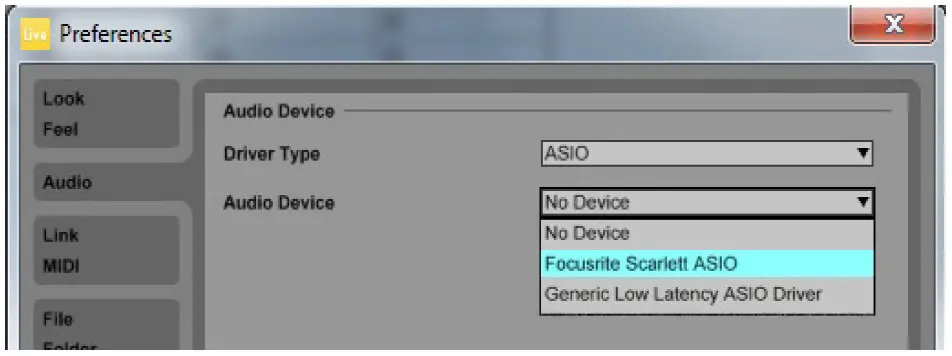
Examples of Usage
The Scarlett 2i2 is an excellent choice for several different recording and monitoring applications. Some typical configurations are shown below.
Connecting a microphone or instrument
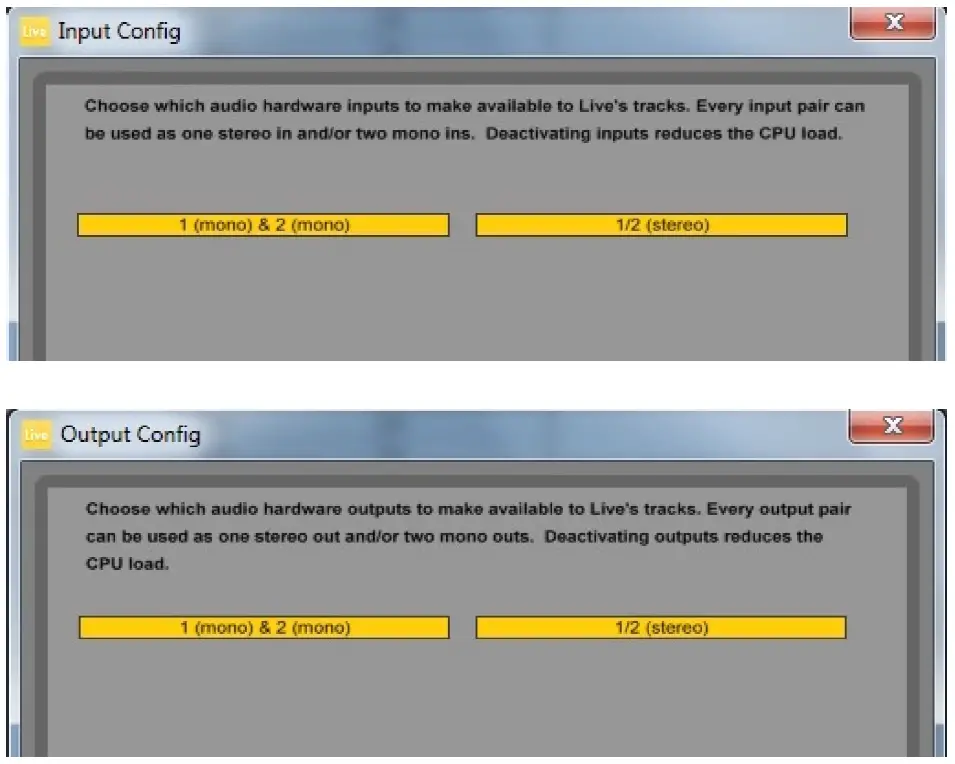
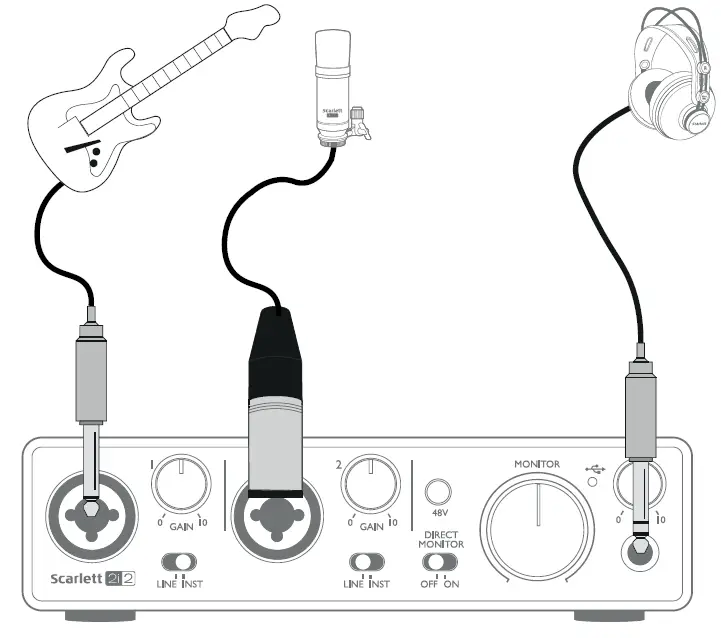
This setup illustrates the most typical configuration for recording with DAW software on your Mac or PC. In this case, you might record guitar through Input 1 and vocals through Input 2 into Ableton Live Lite, while monitoring the playback from the DAW via headphones (or speakers).
The front panel input sockets are “Combo” type, which accept either an XLR male connector (you will probably have one on the end of your microphone cable) or a ¼” (6.35 mm) jack plug. If you are using a capacitor (or “condenser”) microphone, you will need to turn on the 48 V phantom power.
Note the Scarlett 2i2 has no “Mic/line” switch – the Focusrite preamplifier stage is automatically configured for a microphone when you plug an XLR into the input, and for a line or instrument when you connect a jack plug. Set the LINE/INST switch next to the socket to INST if you are connecting musical instrument (a guitar in the example) via an ordinary 2-pole (TS) guitar jack, or to LINE if you are connecting a line level source such as a keyboard, synthesiser or the balanced output of an external audio mixer via a 3-pole (TRS) jack. Note the Combo connector accepts both TRS and TS types of jack plug.
Recording with a microphone
The Scarlett Studio CM25 MkII microphone supplied with Scarlett Studio is a studio quality condenser mic which is ideal for recording vocals and most acoustic instruments. Connect the CM25 MkII to one of the Scarlett 2i2’s two front panel inputs with the cable supplied. Note that the cable has a male and a female connector; the female end connects to the microphone and the male end into the Scarlett 2i2.
Condenser microphones (also sometimes referred to as “capacitor” microphones) require a source of DC power to operate. This is almost always supplied by “phantom” powering from the mic pre-amp to which the mic is connected (early and special-purpose condenser mics might have a separate power supply). For the CM25 MkII (or any other condenser mic) to work with the Scarlett 2i2, press the 48V button on the front panel (see front panel diagram on page 14 item [3]). We recommend that you follow the following sequence:
- Turn the input gain [2] to minimum
- Connect the microphone
- Press the 48V button
- Increase the input gain to the required level
Enabling the Scarlett 2i2’s phantom power applies 48 V DC to the XLR portion of BOTH inputs. If you are only using a single microphone, do not plug anything else (like the balanced output of another item of equipment) into the other input with an XLR connector. Applying 48 V to the output circuitry of other equipment may permanently damage it. The other input is perfectly safe to use with a TRS jack plug.
Microphone Dos and Don’ts
A guide to microphone technique is beyond the scope of this User Guide, but if you are new to recording with a studio quality microphone, you need to observe a few rules.
DO use a mic stand. The CM25 MkII has an industry-standard 5/8” threaded insert which allows it to be mounted on most mic stands. An 3/8” adaptor is included to allow it to be fitted to mic stands that have this thread size. Inexpensive short, long and boom stands are readily available from music stores.
DO observe the microphone’s orientation. The CM25 MkII has a cardioid response pattern; this basically means that it has a “front” and a “back”, and if you point it the wrong way round, it will sound odd. The front of the CM25 MkII can be identified by the CM25 MkII logo.
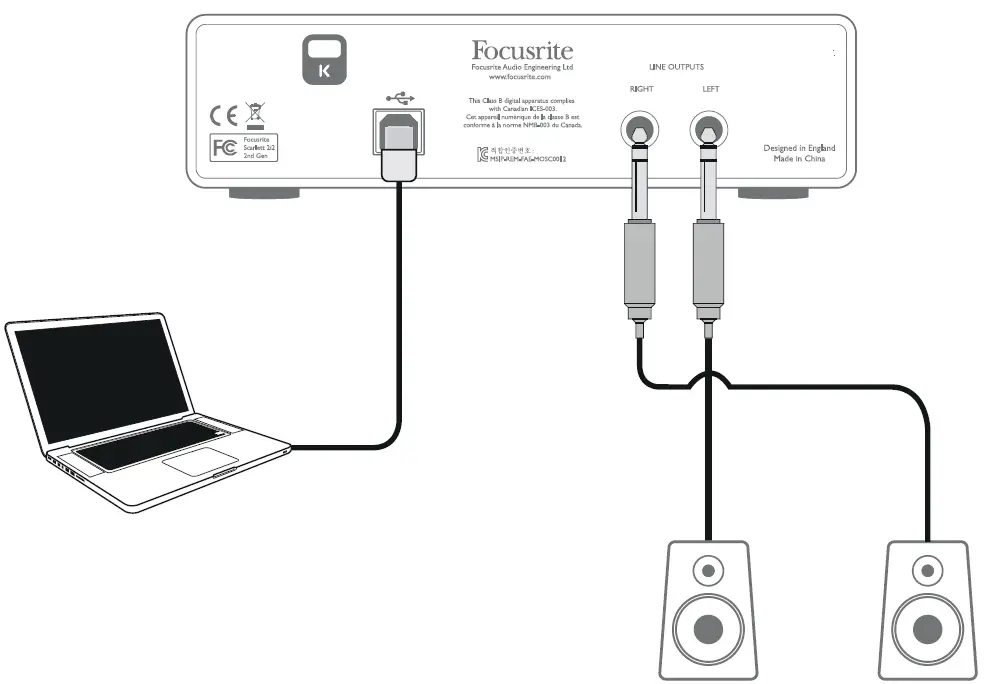
DON’T ignore the room acoustics. You probably won’t have the luxury of a recording studio’s perfect acoustics. Be aware of how reverberant the room is. Reverberation is neither good nor bad, but frequently inappropriate! Some instruments will benefit from being recorded in a reverberant space, others won’t. A “dead” acoustic is generally better than a “live” one, because reverberation can be added in the mixing process, but room reverberation on the recording can’t be removed.
DON’T blow into a microphone to test it! Lightly rub or scratch the grille instead.
DO experiment with microphone placement. Remember you will not only be recording the vocal or instrument, but the effect of the microphone position relative to the voice or instrument as well, and this will be affected by the room acoustics. Moving the mic around, and trying recordings at different distances and angles to the source will produce different sounding results, some of which will be better than others.
DO use the CM25 MkII to mic up a guitar amplifier if you want to include the contribution to the sound that the amplifier makes. But be aware that very high sound levels can be produced very close to the loudspeaker, and if you need high volume, you may get a better result by moving the mic away from the amplifier. Also, be aware that you will get a subtly different sound if you point the mic at the centre of the loudspeaker cone compared to the edge.
DON’T forget that a microphone is unforgiving – it will not only pick up what you are trying to record, but any other sound source in the room, like a clock, the aircon, heating, or a chair creaking. You know how you take those holiday photos of a great bit of scenery and it’s only when you look at the pictures later that you see the power cables right across the view? It’s the same with recording. You might not notice extraneous sounds at the time, but the mic will and you’ll hear them on the recording. To remove any unwanted low frequency rumble, it is advisable that the High Pass Filter (HPF) on the mic’s DAW channel is enabled.
Using Direct Monitoring
You will frequently hear the term “latency” used in connection with digital audio systems. In the case of the simple DAW recording application described above, latency is the time it takes for your input signals to pass through your computer and audio software. Latency can be a problem for a performer who wishes to record while monitoring their input signals.
The Scarlett 2i2 is fitted with a “Direct Monitoring” option, which overcomes this problem.
Setting the front panel DIRECT MONITOR switch to ON will route your input signals directly to the Scarlett 2i2’s headphone and main monitor outputs. This enables you to hear yourself with zero latency – i.e., in “real time” – along with the computer playback. The input signals to your computer are not affected in any way by this setting.
When DIRECT MONITOR is set to ON, ensure that Ableton Live Lite (or other DAW) is not set to route its input (what you are currently recording) to its output. If it is, you will hear yourself twice, with one signal audibly delayed as an echo.
Connecting Scarlett 2i2 to headphones
The Scarlett 2i2 Studio package includes a pair of high quality headphones, the Scarlett Studio HP60 MkIIs. They are lightweight and durable, and should prove comfortable to wear for extended periods. The headband is adjustable.
The HP60 MkIIs have a low noise, oxygen-free copper cable, fitted with a ¼” (6.35 mm) 3-pole (TRS) jack plug. This should be connected to the socket at the right hand side of the Scarlett 2i2 front panel (indicated by a symbol). The Scarlett 2i2’s headphone output is, of course, suitable for use with other models of headphones.
The volume in the headphones can be adjusted by the rotary control immediately above the socket.
Please be aware that headphones are capable of generating very high sound pressure levels at the ear; prolonged exposure to high sound levels may impair your hearing. Never turn headphones volume up any further than necessary.
Connecting Scarlett 2i2 to loudspeakers
The 1/4” jack outputs on the rear panel can be used to connect monitoring speakers. Self-powered monitors (i.e., typical computer speakers) incorporate internal amplifiers, and may be connected directly. Larger, passive loudspeakers will require a separate stereo amplifier; in this case, the rear panel outputs should be connected to the amplifier’s inputs.
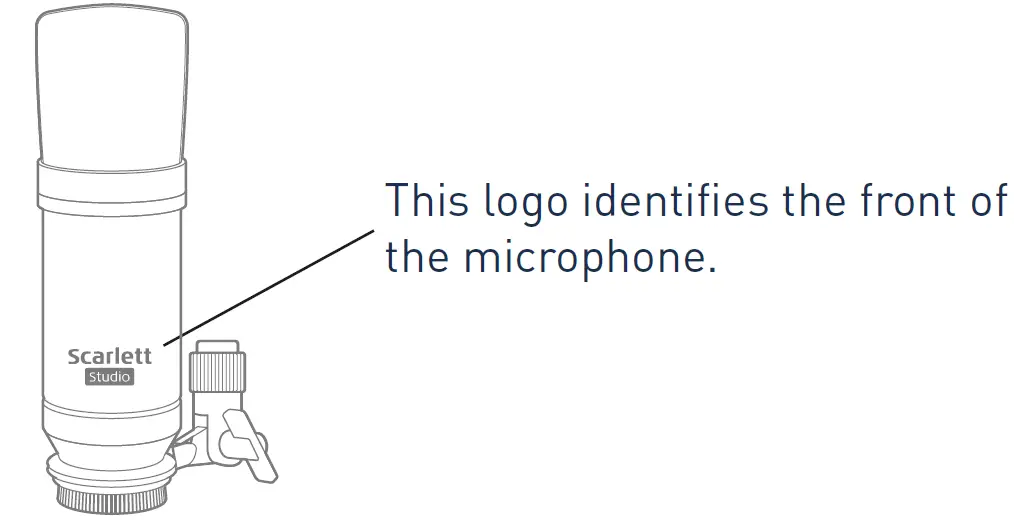
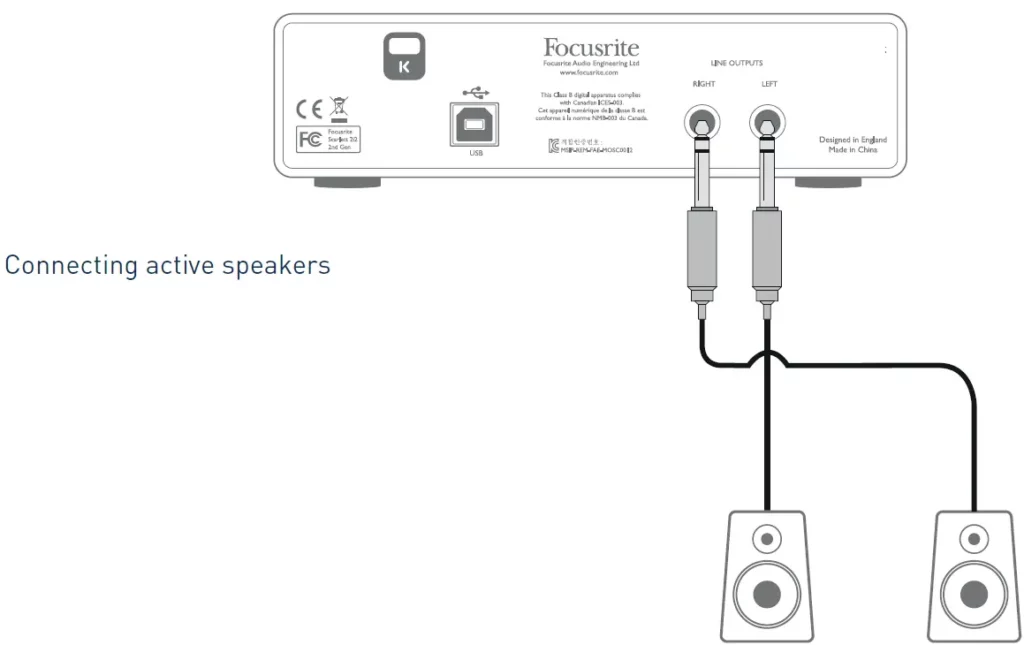
The line output connectors are 3-pole (TRS) ¼” (6.35 mm) jack sockets, and are electronically balanced. Typical consumer (hi-fi) amplifiers and small powered monitors will have unbalanced inputs, either on phono (RCA) sockets, or via a 3.5 mm 3-pole jack plug intended for direct connection to a computer. In either case, use a suitable connecting cable with jack plugs at one end.
Professional power amplifiers will generally have balanced inputs.
HARDWARE FEATURES
Front Panel
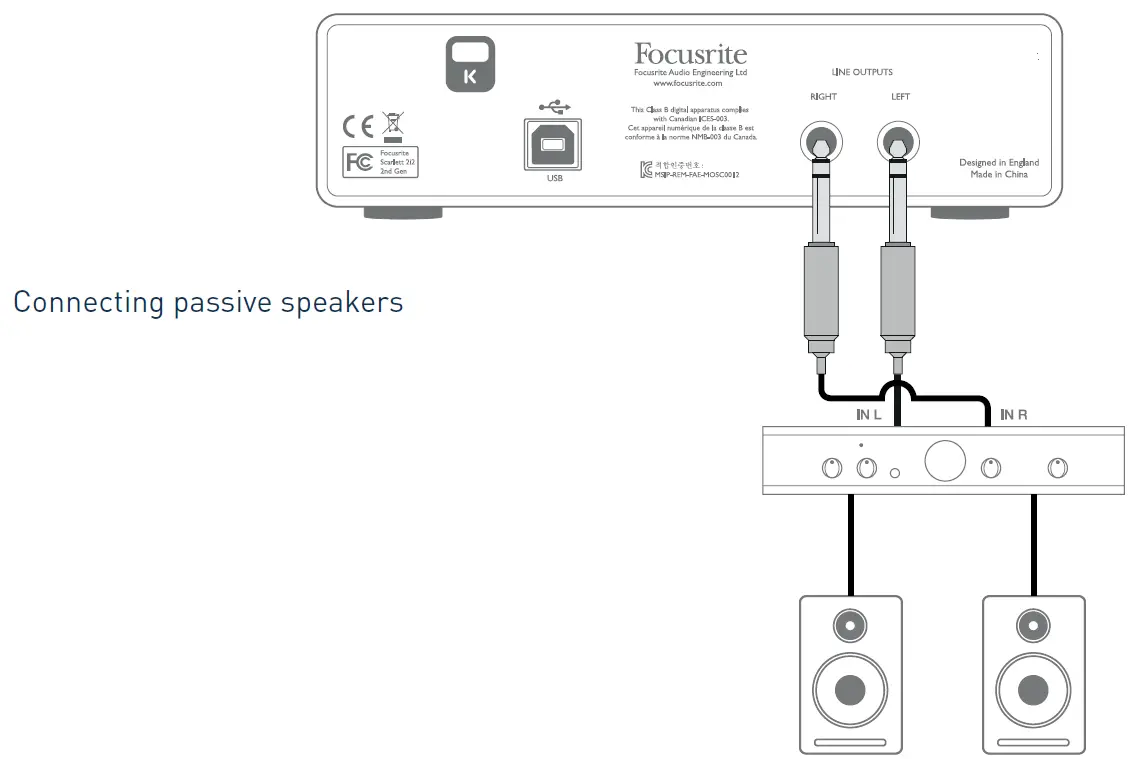
The Front Panel includes the input connectors for Mic, Line and Instrument signals, as well as the input gain and monitoring controls.
- Inputs 1 & 2 – “Combo” type input sockets – connect microphones, instruments (e.g., guitar), or line level signals via XLR or ¼” (6.35 mm) jacks as appropriate.
- GAIN 1 and GAIN 2 – adjust the input gain for input signals on inputs 1 and 2 respectively. The gain controls have LED ‘rings’ to confirm signal level: green indicates an input level of at least – 24 dBFS (i.e., ‘signal present’), the ring then turns red when signal level reaches 0 dBFS, indicating digital clipping.
- 48V – phantom power switch for mic inputs – enables 48 V phantom power at XLR contacts of both Combo connectors. The CM25 MkII microphone supplied with the Scarlett 2i2 Studio package requires phantom power.
- LINE/INST – Line/Instrument level switches for each input – switches gain and input impedance to suit instrument or line level signals.
- MONITOR – main monitor output level control – sets the output level at the main (rear panel) outputs 1 and 2.
- USB LED – illuminates when the unit receives USB bus power and is confirmed by the computer as connected and operating correctly.
- DIRECT MONITOR – allows you to select how you monitor your live recording – either via the DAW or directly (zero latency).
- Headphone level – adjusts the output level at the front panel stereo headphone output.
- Headphone socket – ¼” TRS output jack – connect your stereo headphones here.
Back Panel
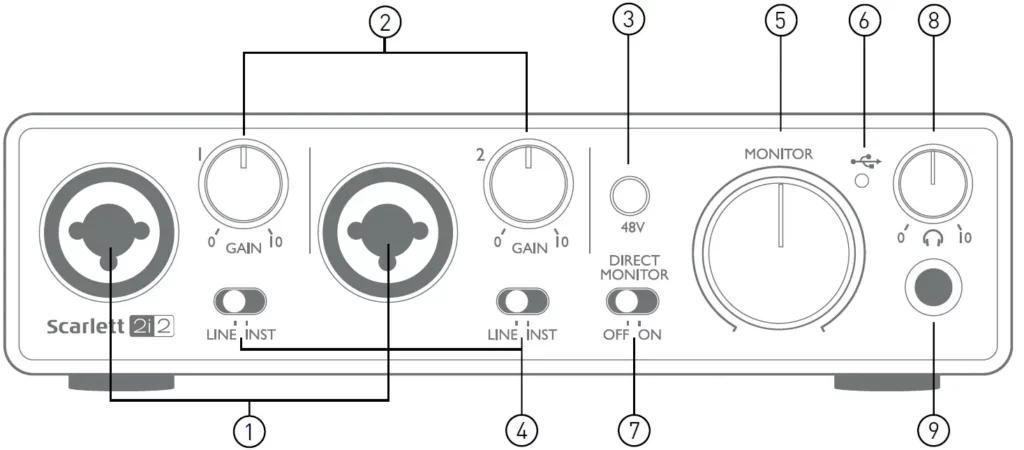
10. K (Kensington security lock) – secure your Scarlett 2i2 to a suitable structure if desired. Please see www.kensington.com/kensington/us/us/s/1704/kensington-security-slot.aspx for further information on how to use this feature.
11. USB 2.0 port – Type B connector; connect to your computer with cable supplied.
12. LINE OUTPUTS: LEFT and RIGHT – 2 x ¼” (6.35 mm) TRS jack sockets; +10 dBu output level (variable), electronically balanced. Either ¼” TRS (balanced connection) or TS (unbalanced connection) jack plugs can be used.
IMPORTANT: Line Outputs 1 and 2 do not have anti-thump, please make sure you power on your amplifier or monitor speakers last to avoid thumps, pops or clicks when you power on your computer and interface.
SPECIFICATIONS
Performance Specifications
| Clock Source | Internal |
| Supported sample rates | 44.1 kHz, 48 kHz, 88.2 kHz, 96 kHz, 176.4 kHz, 192 kHz |
| Microphone Inputs | |
| Dynamic Range | 106 dB (A-weighted) |
| Frequency Response | 20 Hz to 20 kHz ±0.1 dB |
| THD+N | <0.002% (minimum gain, -1 dBFS input with 22 Hz/22 kHz bandpass filter) |
| Noise EIN | -128 dB (A-Weighted) |
| Maximum Input Level | +4 dBu |
| Gain Range | 50 dB |
| Line Inputs | |
| Dynamic Range | 106 dB (A-weighted) |
| Frequency Response | 20 Hz to 20 kHz, ±0.1 dB |
| THD+N | <0.003% (minimum gain, -1dBFS input with 22 Hz/22 kHz bandpass filter) |
| Maximum Input Level | +22 dBu |
| Gain Range | 50 dB |
| Instrument Inputs | |
| Dynamic Range | 106 dB (A-weighted) |
| Frequency Response | 20 Hz to 20 kHz, ±0.1 dB |
| THD+N | <0.02% (minimum gain, -1 dBFS input with 22 Hz/22 kHz bandpass filter) |
| Maximum Input Level | +13 dBu |
| Gain Range | 50 dB |
| Line Outputs 1 & 2 (balanced) | |
| Dynamic Range | 106 dB (A-weighted) |
| Maximum Output Level | +10 dBu |
| THD+N Outputs (1-2) | <0.002% (minimum gain, -1 dBFS input 1 kHz, with 22 Hz/22 kHz bandpass filter) |
| Headphone Outputs | |
| Dynamic Range | 107 dB (A-weighted) |
| Maximum Output Level | > +10 dBu |
| THD+N | <0.002% (minimum gain, -1 dBFS input, 1 kHz, with 22 Hz/22 kHz bandpass filter) |
Physical and Electrical Characteristics
| Analogue Inputs | |
| Connectors | XLR “Combo” type: Mic/Line/Inst (Inputs 1-2) on front panel |
| Mic/Line switching | Automatic |
| Line/Instrument switching | 2 x front panel switches |
| Phantom power | Shared 48 V phantom power switch for inputs 1 & 2 (XLR connections only) |
| Analogue Outputs | |
| Balanced outputs | 2 x ¼” TRS jacks on rear panel |
| Stereo headphone output | ¼” TRS jack on front panel |
| Main output level control | On front panel |
| Headphones level control | |
| Other I/O | |
| USB | 1 x USB 2.0 Type B connector |
| Front Panel Indicators | |
| USB power | LED |
| Gain Halos | Colour-coded LED rings (concentric with GAIN controls) |
| Phantom power | LED (within 48V button) |
| Weight and Dimensions | |
| W x H x D | 145 mm x 45 mm x 115 mm
5.7 in x 1.77 in x 4.53 in |
| Weight | 0.60 kg
1.32 lb |
Scarlett Studio CM25 MkII Microphone Specifications
| Capsule | |
| Type | 20 mm dia. condenser element |
| Response type | Cardioid |
| Mounting | Standard 5/8” female; 3/8” adaptor supplied |
| Performance | |
| Frequency response | 30 Hz to 20 kHz |
| Sensitivity | -36 dB ±2 dB (0 dB = 1 V/Pa) |
| Self noise | 18 dBA |
| Maximum SPL | 130 dB (1 kHz) |
| S/N ratio | 76 dB (A-weighted) |
| Impedance | 150 ohms |
| Power | Via 48 V phantom supply |
Scarlett HP60 MkII Headphones Specifications
| Type | Closed |
| Driver diameter | 53 mm |
| Impedance | 60 ohms |
| Sensitivity SPL | 94 dB ±3 dB |
| Frequency response | 10 Hz to 30 kHz |
| Max. power rating | 1.2 W |
| Cable length | 3 m (approx.) |
| Connectors | 3.5 mm / 6.35 mm dia. (via adaptor) |
| Weight | 280 g (inc. cable) |
TROUBLESHOOTING
For all troubleshooting queries, please visit the Focusrite Help Centre where you will find articles covering numerous troubleshooting examples:
COPYRIGHT AND LEGAL NOTICES
Focusrite is a registered trade mark and Scarlett 2i2 and Scarlett 2i2 Studio are trade marks of Focusrite Audio Engineering Limited.
All other trade marks and trade names are the property of their respective owners.
2016 © Focusrite Audio Engineering Limited. All rights reserved.

